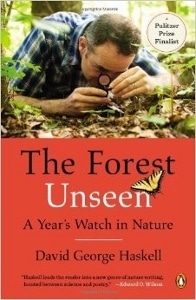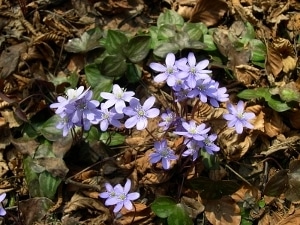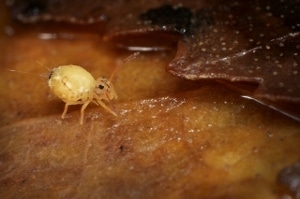A small universe underfoot…
Author: David George Haskell
 It’s counterintuitive. The closer you look at any natural space – the smaller the scale – the more there is to talk about. The big picture isn’t as revealing as you might think, frequently hiding all sorts of fascinating minutiae. While I’ll make no claims that such thoughts are particularly profound, it’s easy to miss countless small things as we humans go about our routine, biologically large scale lives. Scientist David George Haskell – armed with his handy magnifying loupe – spent a year trying to correct this bias, exploring a tiny patch of old-growth forest in eastern Tennessee. The result is The Forest Unseen – and despite decades of nature reading, I’ve never seen it done better.
It’s counterintuitive. The closer you look at any natural space – the smaller the scale – the more there is to talk about. The big picture isn’t as revealing as you might think, frequently hiding all sorts of fascinating minutiae. While I’ll make no claims that such thoughts are particularly profound, it’s easy to miss countless small things as we humans go about our routine, biologically large scale lives. Scientist David George Haskell – armed with his handy magnifying loupe – spent a year trying to correct this bias, exploring a tiny patch of old-growth forest in eastern Tennessee. The result is The Forest Unseen – and despite decades of nature reading, I’ve never seen it done better.
After a brief hike in the woods on the grounds of The University of the South, where he teaches, Professor Haskell marked off a circle just over a meter in diameter, narrowing his focus for the book. Visiting this small patch of woodland frequently over a year, the author reveals myriad secrets about the natural world from hickory tree to fungal hypha. Whether he’s writing about the sex life of snails, how trees “see” in color or the details of hawk anatomy, he never runs out of things to talk about. Even something as simple as the cloven hoof print of a white tailed deer quickly leads to an extensive and fascinating discussion of bacterial biochemistry.
Transforming tangential thinking into a literary art form, Haskell can take the smallest detail – like the tiny anthers on a Hepatica flower – and turn it into a wide ranging exploration of the sex life of flowers, which might then lead to a discussion of ant evolution or photosynthesis. And on it goes. Day after day in the life of this one small patch of the natural world. Eschewing any human interference, the author tries to make sure that he doesn’t unduly influence events, using caution when peeking under some wet leaves or debating whether he should remove a stray golf ball.
Every entry in Haskell’s wide ranging account, from coyotes and salamanders to katydids and mushrooms, is packed with fascinating commentary and observations. I repeatedly found references to the many diminutive creatures I often encounter in my backyard flower garden – way up in southern Wisconsin – learning all sorts of intriguing details about their lives in the process. You may have a green patch of your own, whether it’s a garden, a local park or a nearby nature preserve, if so, Haskell’s work is sure to provide all sorts of enlightenment.
A Pulitzer Prize finalist in 2013, The Forest Unseen is a consistently engaging and eye-opening account of the many lives we so frequently ignore as we go about our macroscopic lives. Repeatedly finding awe in less than one square meter, Haskell has assembled an entertaining menagerie – from the tiniest spider to the slimiest slug – that’s sure to captivate any nature enthusiast. He left me hoping for a second year.
— D. Driftless
Photos by Archenzo Moggio (Hepatica) and Tim Evison (springtail) (CC BY-SA 3.0)
Other reviews of similarly excellent nature books:
Swampwalker’s Journal / A World in One Cubic Foot / Life Everlasting
- Best Non-Fiction of 2016 - February 1, 2017
- Little Free Library Series — Savannah - May 22, 2015
- Little Free Library Series — Wyoming - November 30, 2014



